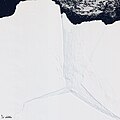Vaizdas:Amery Ice Shelf.jpg

Šios peržiūros dydis: 600 × 600 taškų. Kitos 3 rezoliucijos: 240 × 240 taškų | 480 × 480 taškų | 720 × 720 taškų.
Didesnės raiškos iliustracija (720 × 720 taškų, rinkmenos dydis: 160 KiB, MIME tipas: image/jpeg)
Rinkmenos istorija
Paspauskite ant datos/laiko, kad pamatytumėte rinkmeną tokią, kokia ji buvo tuo metu.
| Data/Laikas | Miniatiūra | Matmenys | Naudotojas | Paaiškinimas | |
|---|---|---|---|---|---|
| dabartinis | 16:18, 24 vasario 2012 |  | 720 × 720 (160 KiB) | 4ing |
Paveikslėlio naudojimas
Paveikslėlis yra naudojamas šiuose puslapiuose:
Visuotinis rinkmenos naudojimas
Ši rinkmena naudojama šiose viki svetainėse:
- Naudojama de.wikipedia.org
- Naudojama en.wikipedia.org
- Naudojama fr.wikipedia.org
- Naudojama he.wikipedia.org
- Naudojama it.wikipedia.org
- Naudojama ka.wikipedia.org
- Naudojama mk.wikipedia.org
- Naudojama nn.wikipedia.org
- Naudojama pl.wikipedia.org
- Naudojama ru.wikipedia.org
- Naudojama sv.wikipedia.org
- Naudojama uk.wikipedia.org
- Naudojama www.wikidata.org
- Naudojama zh.wikipedia.org



